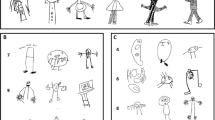Abstract
Previous research has shown that the human figure drawings of severely disturbed children contain more emotional indicators than those of well-adjusted children, whether the well-adjusted children are of the same chronological age or are younger but of the same mental age as the severely disturbed children. This finding suggests that the disturbed children's drawings may be different rather than merely immature. A problem with previous research, however, is that groups have not been matched for drawing ability. In study 1 of this paper each drawing of 44 severely disturbed boys was matched with that of a normal boy according to its score on the Goodenough–Harris scoring system. There was no significant difference between the groups in the number of emotional indicators included in the drawings. Furthermore, in study 2, judges could not discriminate the drawings of the two groups. It was concluded that the differences noted in previous research were most likely due to the poorer drawing ability of the severely disturbed children rather than unusual features in their drawings.
Similar content being viewed by others
Author information
Authors and Affiliations
Additional information
Accepted: 9 May 2000
Rights and permissions
About this article
Cite this article
Cox, M., Catte, M. Severely disturbed children's human figure drawings: are they unusual or just poor drawings?. European Child & Adolescent Psychiatry 9, 301–306 (2000). https://doi.org/10.1007/s007870070034
Issue Date:
DOI: https://doi.org/10.1007/s007870070034




